Cultural Competence Assessment for CHCECE001 Module, Semester 1
VerifiedAdded on 2023/01/09
|22
|6292
|76
Homework Assignment
AI Summary
This document presents a completed assessment for the CHCECE001 unit, which focuses on developing cultural competence in early childhood education. The assessment includes various components such as short answer questions exploring self-identity, cultural values, and responses to diverse cultural scenarios; case studies analyzing different cultural contexts; and research activities related to the Early Years Learning Framework (EYLF) and National Quality Framework (NQF). The assessment also includes reflective journal entries, third-party observations, and workplace observations. The student addresses topics like how educators can support children from diverse backgrounds, the impact of colonization on Indigenous cultures, and the role of the Aboriginal and Torres Strait Islander Social Justice Commissioner. The responses demonstrate an understanding of cultural practices, communication strategies, and the importance of creating inclusive environments for children and families. The document offers a comprehensive overview of cultural competence concepts and their practical application in early childhood settings.
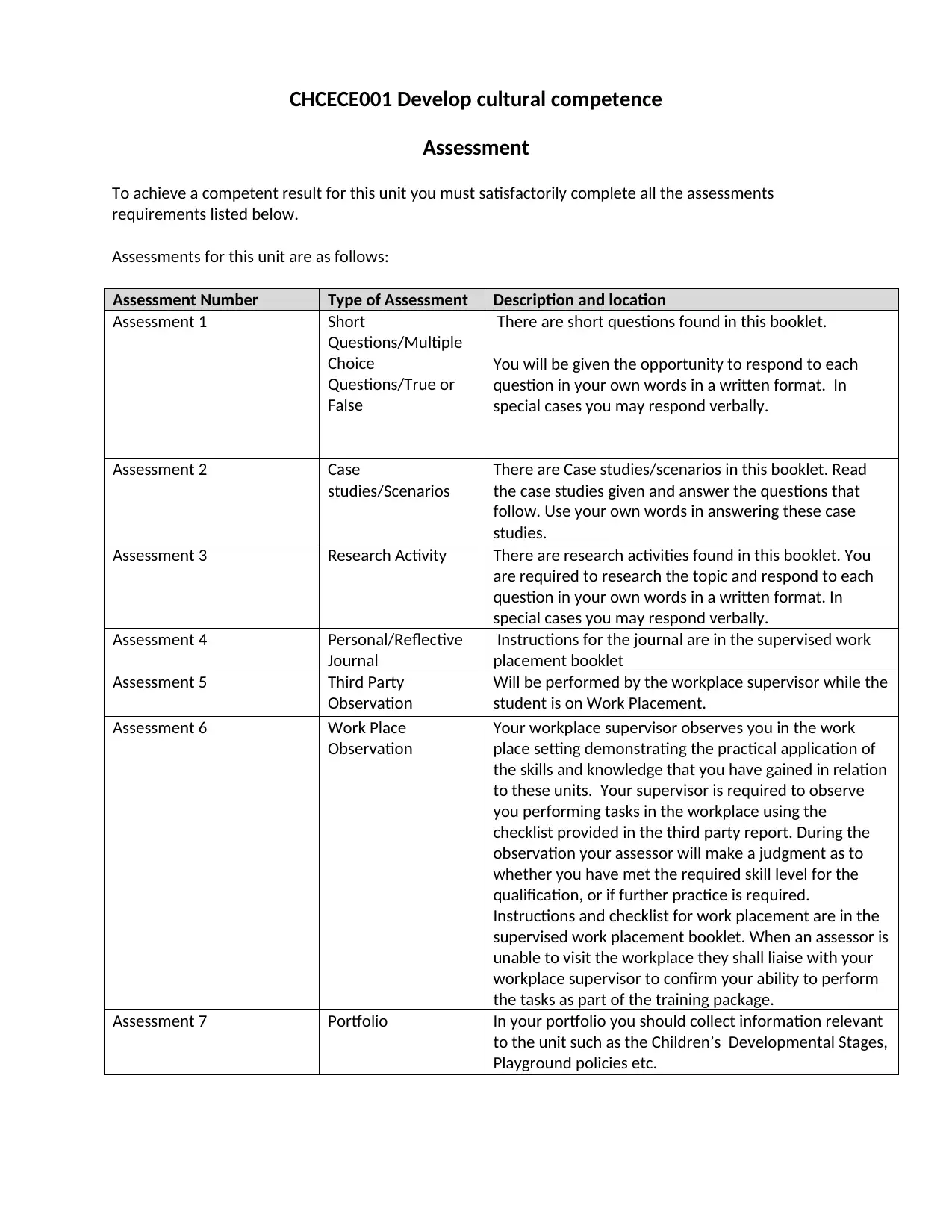
CHCECE001 Develop cultural competence
Assessment
To achieve a competent result for this unit you must satisfactorily complete all the assessments
requirements listed below.
Assessments for this unit are as follows:
Assessment Number Type of Assessment Description and location
Assessment 1 Short
Questions/Multiple
Choice
Questions/True or
False
There are short questions found in this booklet.
You will be given the opportunity to respond to each
question in your own words in a written format. In
special cases you may respond verbally.
Assessment 2 Case
studies/Scenarios
There are Case studies/scenarios in this booklet. Read
the case studies given and answer the questions that
follow. Use your own words in answering these case
studies.
Assessment 3 Research Activity There are research activities found in this booklet. You
are required to research the topic and respond to each
question in your own words in a written format. In
special cases you may respond verbally.
Assessment 4 Personal/Reflective
Journal
Instructions for the journal are in the supervised work
placement booklet
Assessment 5 Third Party
Observation
Will be performed by the workplace supervisor while the
student is on Work Placement.
Assessment 6 Work Place
Observation
Your workplace supervisor observes you in the work
place setting demonstrating the practical application of
the skills and knowledge that you have gained in relation
to these units. Your supervisor is required to observe
you performing tasks in the workplace using the
checklist provided in the third party report. During the
observation your assessor will make a judgment as to
whether you have met the required skill level for the
qualification, or if further practice is required.
Instructions and checklist for work placement are in the
supervised work placement booklet. When an assessor is
unable to visit the workplace they shall liaise with your
workplace supervisor to confirm your ability to perform
the tasks as part of the training package.
Assessment 7 Portfolio In your portfolio you should collect information relevant
to the unit such as the Children’s Developmental Stages,
Playground policies etc.
Assessment
To achieve a competent result for this unit you must satisfactorily complete all the assessments
requirements listed below.
Assessments for this unit are as follows:
Assessment Number Type of Assessment Description and location
Assessment 1 Short
Questions/Multiple
Choice
Questions/True or
False
There are short questions found in this booklet.
You will be given the opportunity to respond to each
question in your own words in a written format. In
special cases you may respond verbally.
Assessment 2 Case
studies/Scenarios
There are Case studies/scenarios in this booklet. Read
the case studies given and answer the questions that
follow. Use your own words in answering these case
studies.
Assessment 3 Research Activity There are research activities found in this booklet. You
are required to research the topic and respond to each
question in your own words in a written format. In
special cases you may respond verbally.
Assessment 4 Personal/Reflective
Journal
Instructions for the journal are in the supervised work
placement booklet
Assessment 5 Third Party
Observation
Will be performed by the workplace supervisor while the
student is on Work Placement.
Assessment 6 Work Place
Observation
Your workplace supervisor observes you in the work
place setting demonstrating the practical application of
the skills and knowledge that you have gained in relation
to these units. Your supervisor is required to observe
you performing tasks in the workplace using the
checklist provided in the third party report. During the
observation your assessor will make a judgment as to
whether you have met the required skill level for the
qualification, or if further practice is required.
Instructions and checklist for work placement are in the
supervised work placement booklet. When an assessor is
unable to visit the workplace they shall liaise with your
workplace supervisor to confirm your ability to perform
the tasks as part of the training package.
Assessment 7 Portfolio In your portfolio you should collect information relevant
to the unit such as the Children’s Developmental Stages,
Playground policies etc.
Paraphrase This Document
Need a fresh take? Get an instant paraphrase of this document with our AI Paraphraser
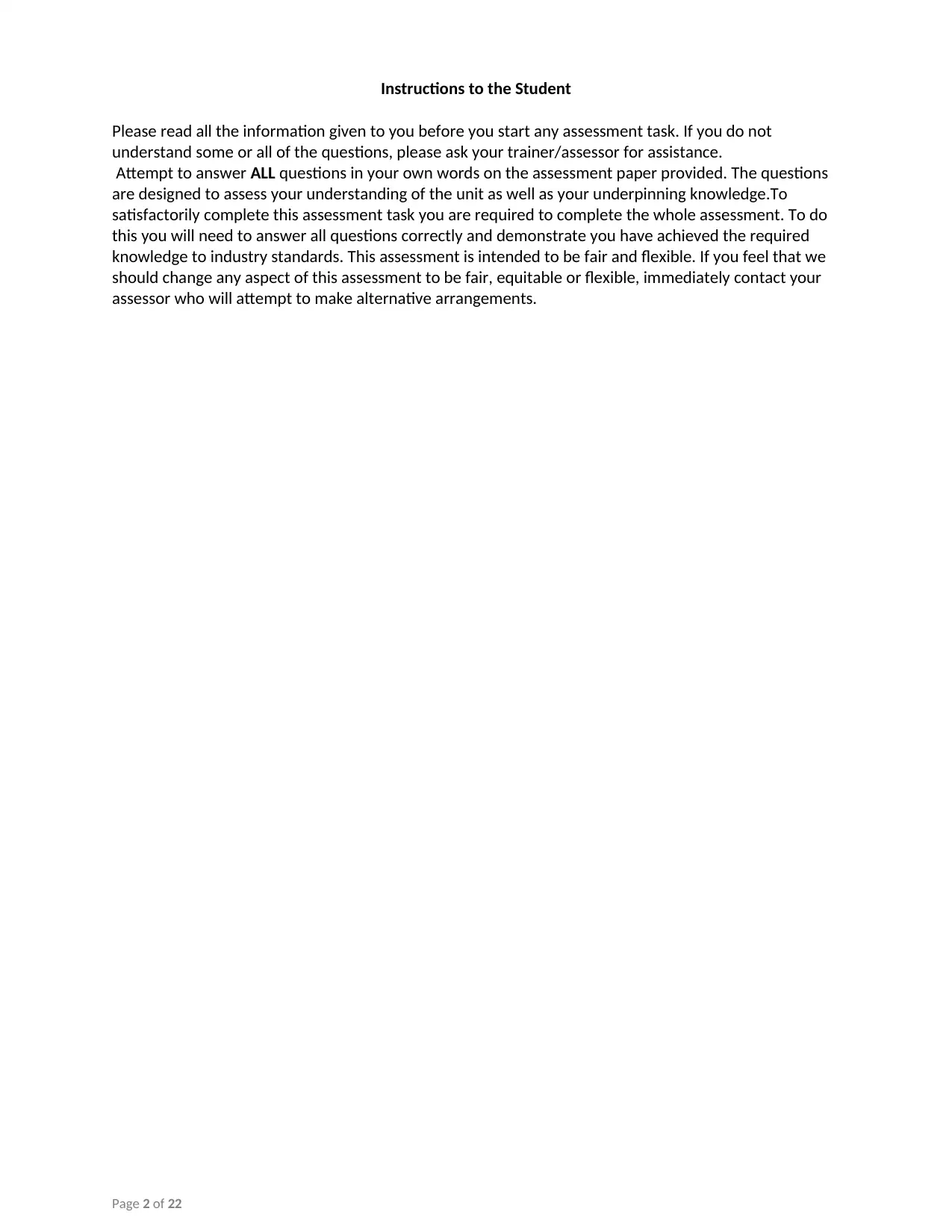
Instructions to the Student
Please read all the information given to you before you start any assessment task. If you do not
understand some or all of the questions, please ask your trainer/assessor for assistance.
Attempt to answer ALL questions in your own words on the assessment paper provided. The questions
are designed to assess your understanding of the unit as well as your underpinning knowledge.To
satisfactorily complete this assessment task you are required to complete the whole assessment. To do
this you will need to answer all questions correctly and demonstrate you have achieved the required
knowledge to industry standards. This assessment is intended to be fair and flexible. If you feel that we
should change any aspect of this assessment to be fair, equitable or flexible, immediately contact your
assessor who will attempt to make alternative arrangements.
Page 2 of 22
Please read all the information given to you before you start any assessment task. If you do not
understand some or all of the questions, please ask your trainer/assessor for assistance.
Attempt to answer ALL questions in your own words on the assessment paper provided. The questions
are designed to assess your understanding of the unit as well as your underpinning knowledge.To
satisfactorily complete this assessment task you are required to complete the whole assessment. To do
this you will need to answer all questions correctly and demonstrate you have achieved the required
knowledge to industry standards. This assessment is intended to be fair and flexible. If you feel that we
should change any aspect of this assessment to be fair, equitable or flexible, immediately contact your
assessor who will attempt to make alternative arrangements.
Page 2 of 22
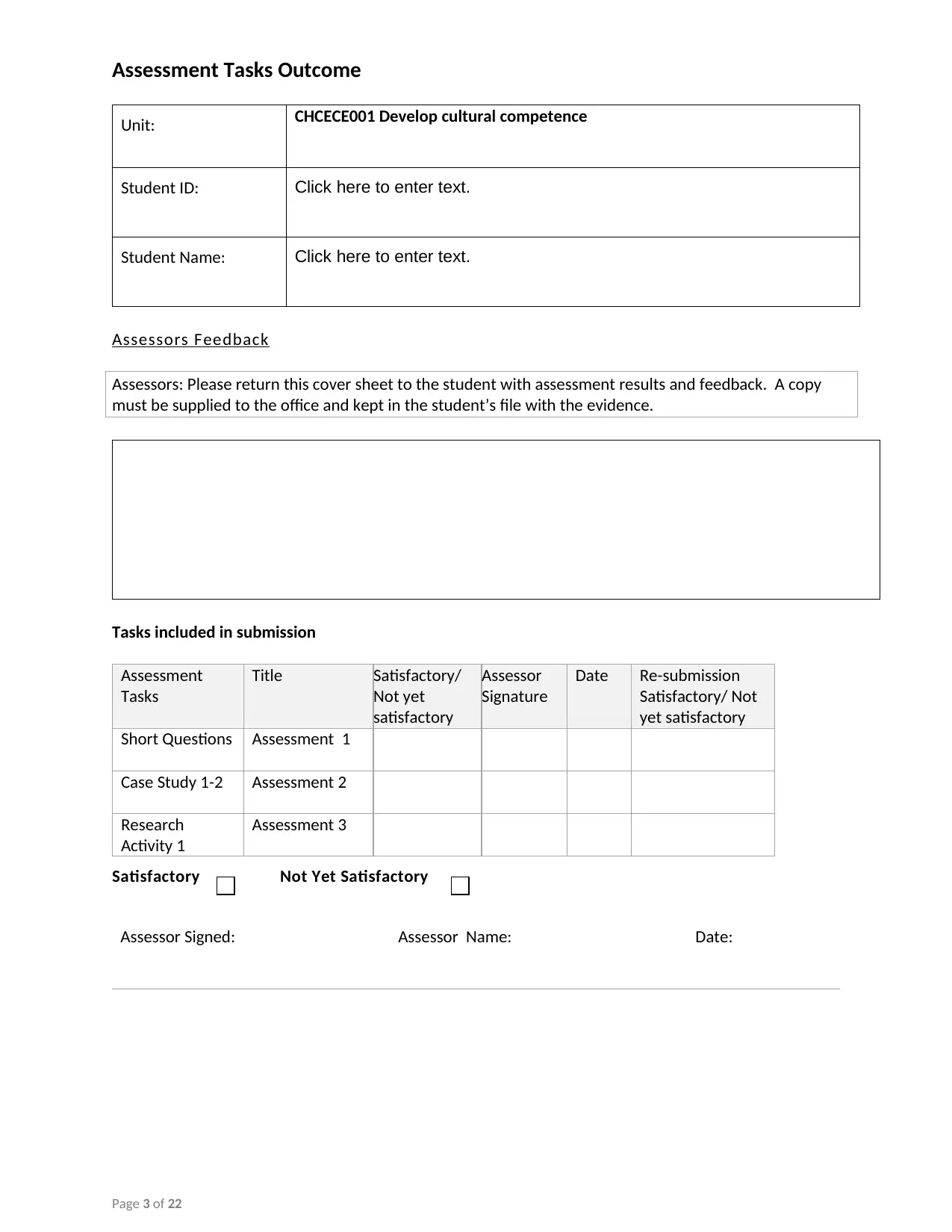
Assessment Tasks Outcome
Unit: CHCECE001 Develop cultural competence
Student ID: Click here to enter text.
Student Name: Click here to enter text.
Assessors Feedback
Assessors: Please return this cover sheet to the student with assessment results and feedback. A copy
must be supplied to the office and kept in the student’s file with the evidence.
Tasks included in submission
Assessment
Tasks
Title Satisfactory/
Not yet
satisfactory
Assessor
Signature
Date Re-submission
Satisfactory/ Not
yet satisfactory
Short Questions Assessment 1
Case Study 1-2 Assessment 2
Research
Activity 1
Assessment 3
Satisfactory Not Yet Satisfactory
Assessor Signed: Assessor Name: Date:
Page 3 of 22
Unit: CHCECE001 Develop cultural competence
Student ID: Click here to enter text.
Student Name: Click here to enter text.
Assessors Feedback
Assessors: Please return this cover sheet to the student with assessment results and feedback. A copy
must be supplied to the office and kept in the student’s file with the evidence.
Tasks included in submission
Assessment
Tasks
Title Satisfactory/
Not yet
satisfactory
Assessor
Signature
Date Re-submission
Satisfactory/ Not
yet satisfactory
Short Questions Assessment 1
Case Study 1-2 Assessment 2
Research
Activity 1
Assessment 3
Satisfactory Not Yet Satisfactory
Assessor Signed: Assessor Name: Date:
Page 3 of 22
⊘ This is a preview!⊘
Do you want full access?
Subscribe today to unlock all pages.

Trusted by 1+ million students worldwide
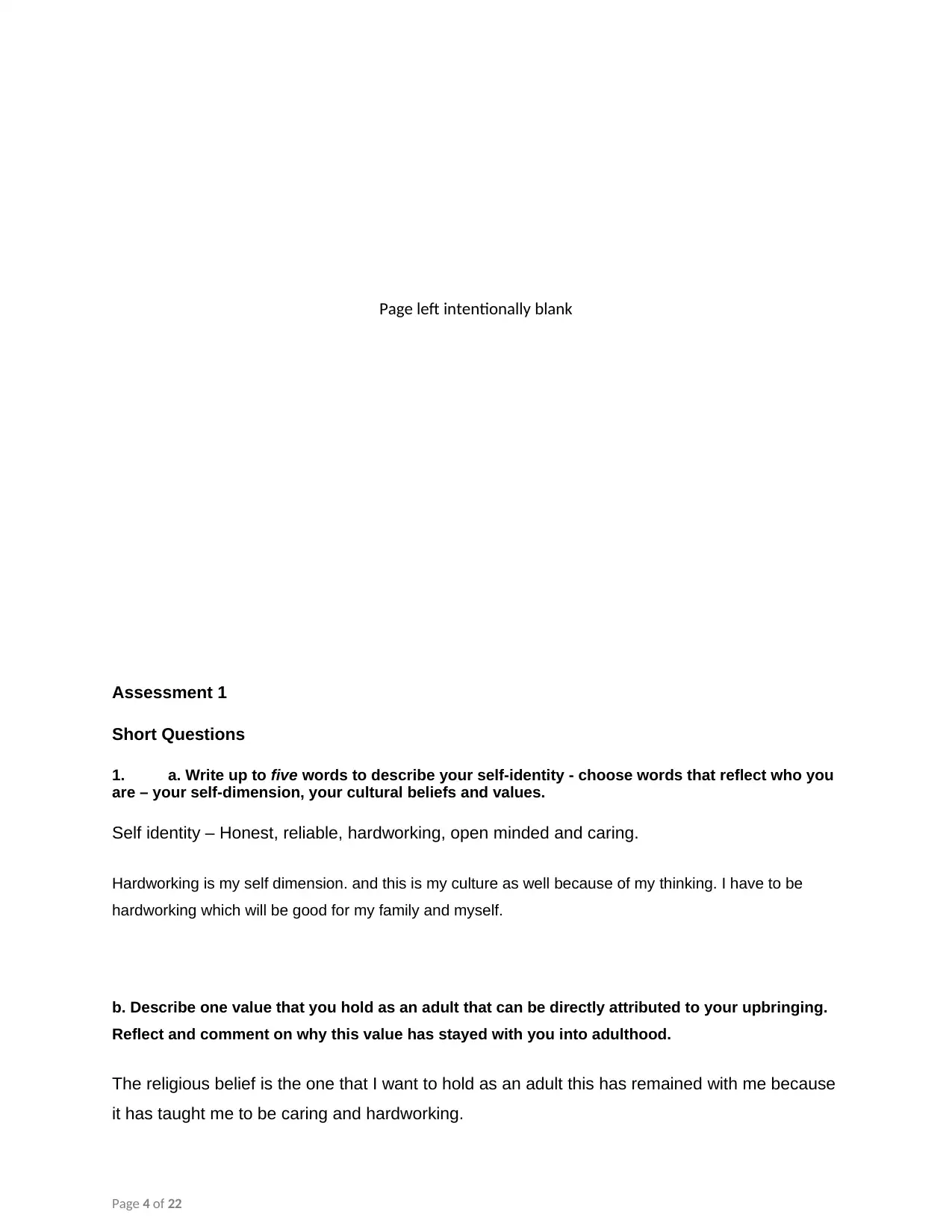
Page left intentionally blank
Assessment 1
Short Questions
1. a. Write up to five words to describe your self-identity - choose words that reflect who you
are – your self-dimension, your cultural beliefs and values.
Self identity – Honest, reliable, hardworking, open minded and caring.
Hardworking is my self dimension. and this is my culture as well because of my thinking. I have to be
hardworking which will be good for my family and myself.
b. Describe one value that you hold as an adult that can be directly attributed to your upbringing.
Reflect and comment on why this value has stayed with you into adulthood.
The religious belief is the one that I want to hold as an adult this has remained with me because
it has taught me to be caring and hardworking.
Page 4 of 22
Assessment 1
Short Questions
1. a. Write up to five words to describe your self-identity - choose words that reflect who you
are – your self-dimension, your cultural beliefs and values.
Self identity – Honest, reliable, hardworking, open minded and caring.
Hardworking is my self dimension. and this is my culture as well because of my thinking. I have to be
hardworking which will be good for my family and myself.
b. Describe one value that you hold as an adult that can be directly attributed to your upbringing.
Reflect and comment on why this value has stayed with you into adulthood.
The religious belief is the one that I want to hold as an adult this has remained with me because
it has taught me to be caring and hardworking.
Page 4 of 22
Paraphrase This Document
Need a fresh take? Get an instant paraphrase of this document with our AI Paraphraser
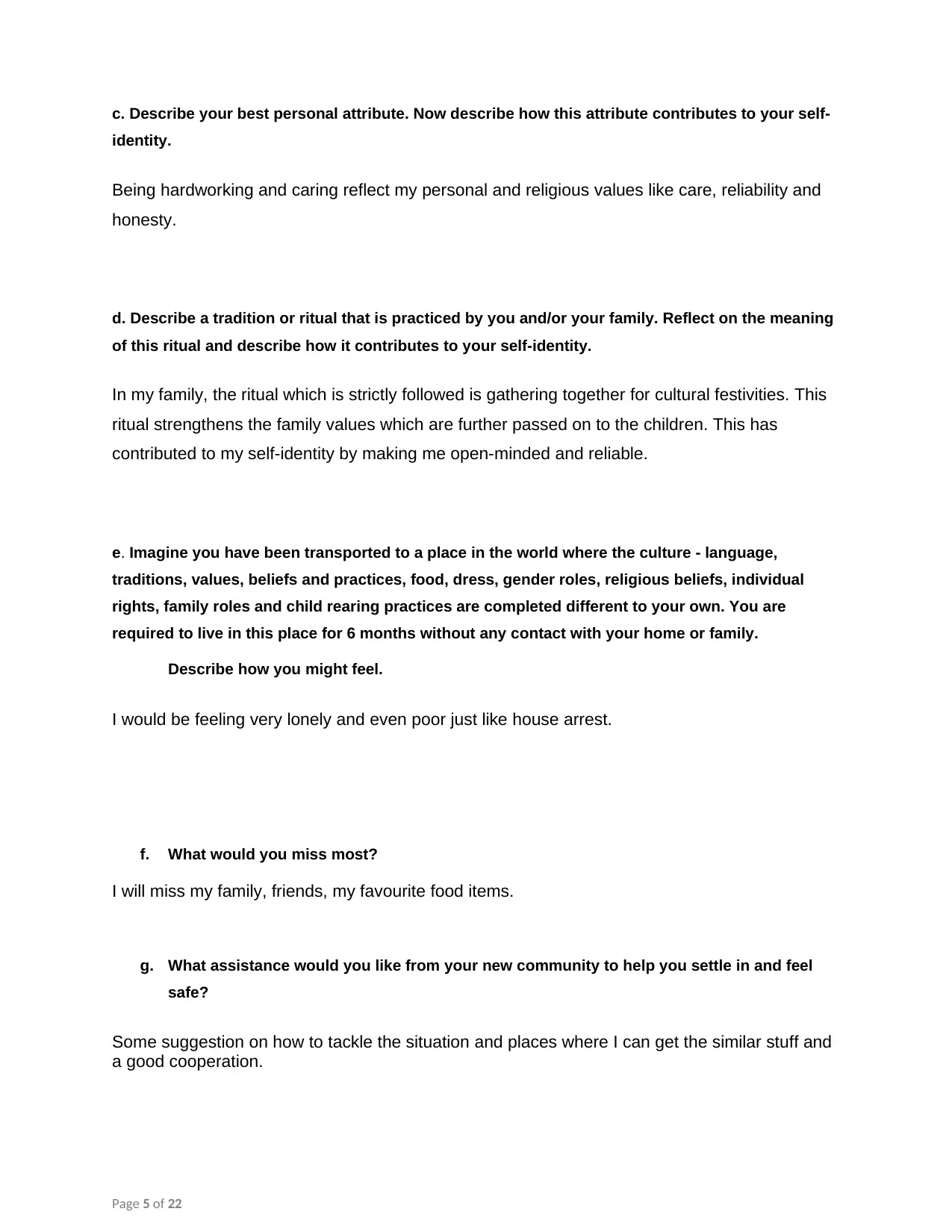
c. Describe your best personal attribute. Now describe how this attribute contributes to your self-
identity.
Being hardworking and caring reflect my personal and religious values like care, reliability and
honesty.
d. Describe a tradition or ritual that is practiced by you and/or your family. Reflect on the meaning
of this ritual and describe how it contributes to your self-identity.
In my family, the ritual which is strictly followed is gathering together for cultural festivities. This
ritual strengthens the family values which are further passed on to the children. This has
contributed to my self-identity by making me open-minded and reliable.
e. Imagine you have been transported to a place in the world where the culture - language,
traditions, values, beliefs and practices, food, dress, gender roles, religious beliefs, individual
rights, family roles and child rearing practices are completed different to your own. You are
required to live in this place for 6 months without any contact with your home or family.
Describe how you might feel.
I would be feeling very lonely and even poor just like house arrest.
f. What would you miss most?
I will miss my family, friends, my favourite food items.
g. What assistance would you like from your new community to help you settle in and feel
safe?
Some suggestion on how to tackle the situation and places where I can get the similar stuff and
a good cooperation.
Page 5 of 22
identity.
Being hardworking and caring reflect my personal and religious values like care, reliability and
honesty.
d. Describe a tradition or ritual that is practiced by you and/or your family. Reflect on the meaning
of this ritual and describe how it contributes to your self-identity.
In my family, the ritual which is strictly followed is gathering together for cultural festivities. This
ritual strengthens the family values which are further passed on to the children. This has
contributed to my self-identity by making me open-minded and reliable.
e. Imagine you have been transported to a place in the world where the culture - language,
traditions, values, beliefs and practices, food, dress, gender roles, religious beliefs, individual
rights, family roles and child rearing practices are completed different to your own. You are
required to live in this place for 6 months without any contact with your home or family.
Describe how you might feel.
I would be feeling very lonely and even poor just like house arrest.
f. What would you miss most?
I will miss my family, friends, my favourite food items.
g. What assistance would you like from your new community to help you settle in and feel
safe?
Some suggestion on how to tackle the situation and places where I can get the similar stuff and
a good cooperation.
Page 5 of 22
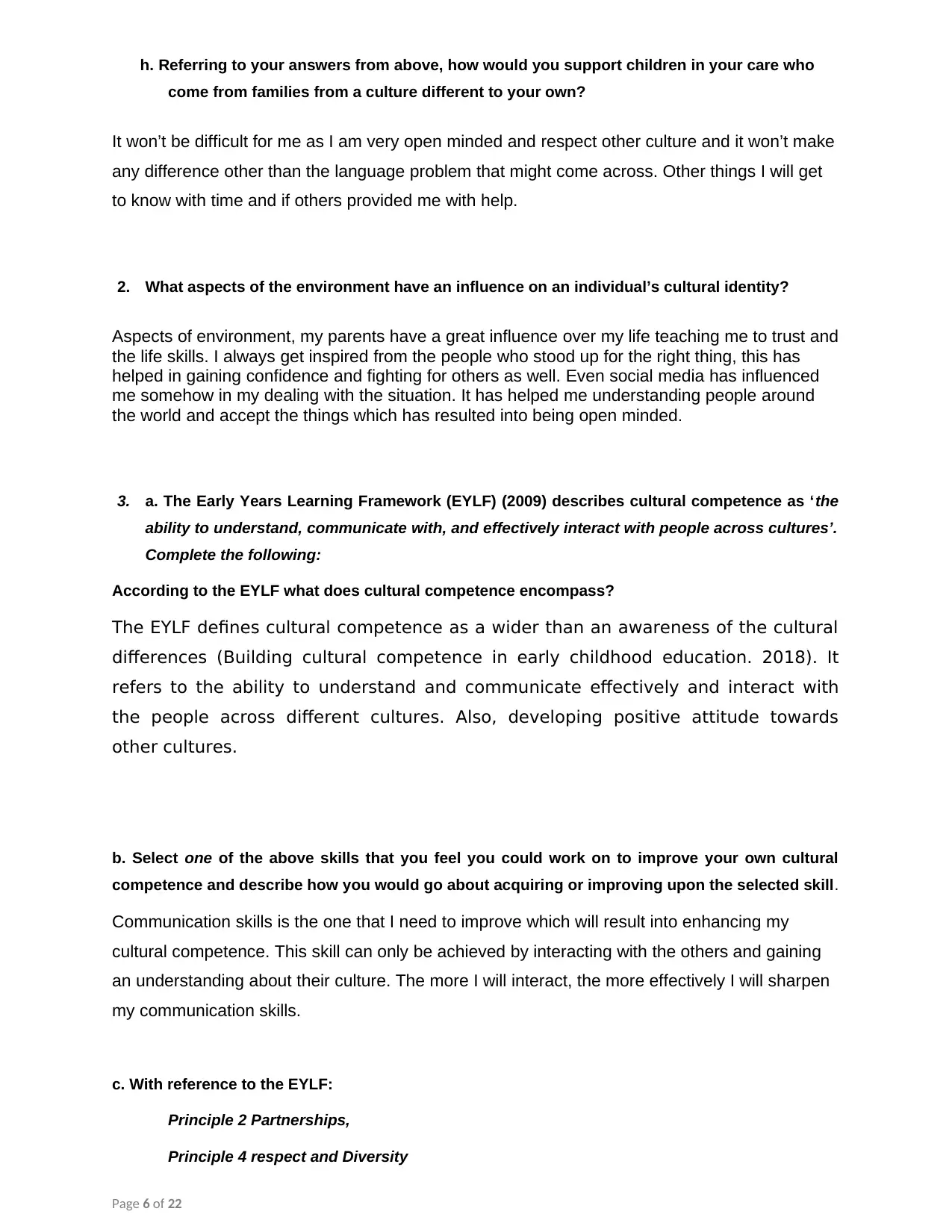
h. Referring to your answers from above, how would you support children in your care who
come from families from a culture different to your own?
It won’t be difficult for me as I am very open minded and respect other culture and it won’t make
any difference other than the language problem that might come across. Other things I will get
to know with time and if others provided me with help.
2. What aspects of the environment have an influence on an individual’s cultural identity?
Aspects of environment, my parents have a great influence over my life teaching me to trust and
the life skills. I always get inspired from the people who stood up for the right thing, this has
helped in gaining confidence and fighting for others as well. Even social media has influenced
me somehow in my dealing with the situation. It has helped me understanding people around
the world and accept the things which has resulted into being open minded.
3. a. The Early Years Learning Framework (EYLF) (2009) describes cultural competence as ‘the
ability to understand, communicate with, and effectively interact with people across cultures’.
Complete the following:
According to the EYLF what does cultural competence encompass?
The EYLF defines cultural competence as a wider than an awareness of the cultural
differences (Building cultural competence in early childhood education. 2018). It
refers to the ability to understand and communicate effectively and interact with
the people across different cultures. Also, developing positive attitude towards
other cultures.
b. Select one of the above skills that you feel you could work on to improve your own cultural
competence and describe how you would go about acquiring or improving upon the selected skill.
Communication skills is the one that I need to improve which will result into enhancing my
cultural competence. This skill can only be achieved by interacting with the others and gaining
an understanding about their culture. The more I will interact, the more effectively I will sharpen
my communication skills.
c. With reference to the EYLF:
Principle 2 Partnerships,
Principle 4 respect and Diversity
Page 6 of 22
come from families from a culture different to your own?
It won’t be difficult for me as I am very open minded and respect other culture and it won’t make
any difference other than the language problem that might come across. Other things I will get
to know with time and if others provided me with help.
2. What aspects of the environment have an influence on an individual’s cultural identity?
Aspects of environment, my parents have a great influence over my life teaching me to trust and
the life skills. I always get inspired from the people who stood up for the right thing, this has
helped in gaining confidence and fighting for others as well. Even social media has influenced
me somehow in my dealing with the situation. It has helped me understanding people around
the world and accept the things which has resulted into being open minded.
3. a. The Early Years Learning Framework (EYLF) (2009) describes cultural competence as ‘the
ability to understand, communicate with, and effectively interact with people across cultures’.
Complete the following:
According to the EYLF what does cultural competence encompass?
The EYLF defines cultural competence as a wider than an awareness of the cultural
differences (Building cultural competence in early childhood education. 2018). It
refers to the ability to understand and communicate effectively and interact with
the people across different cultures. Also, developing positive attitude towards
other cultures.
b. Select one of the above skills that you feel you could work on to improve your own cultural
competence and describe how you would go about acquiring or improving upon the selected skill.
Communication skills is the one that I need to improve which will result into enhancing my
cultural competence. This skill can only be achieved by interacting with the others and gaining
an understanding about their culture. The more I will interact, the more effectively I will sharpen
my communication skills.
c. With reference to the EYLF:
Principle 2 Partnerships,
Principle 4 respect and Diversity
Page 6 of 22
⊘ This is a preview!⊘
Do you want full access?
Subscribe today to unlock all pages.

Trusted by 1+ million students worldwide
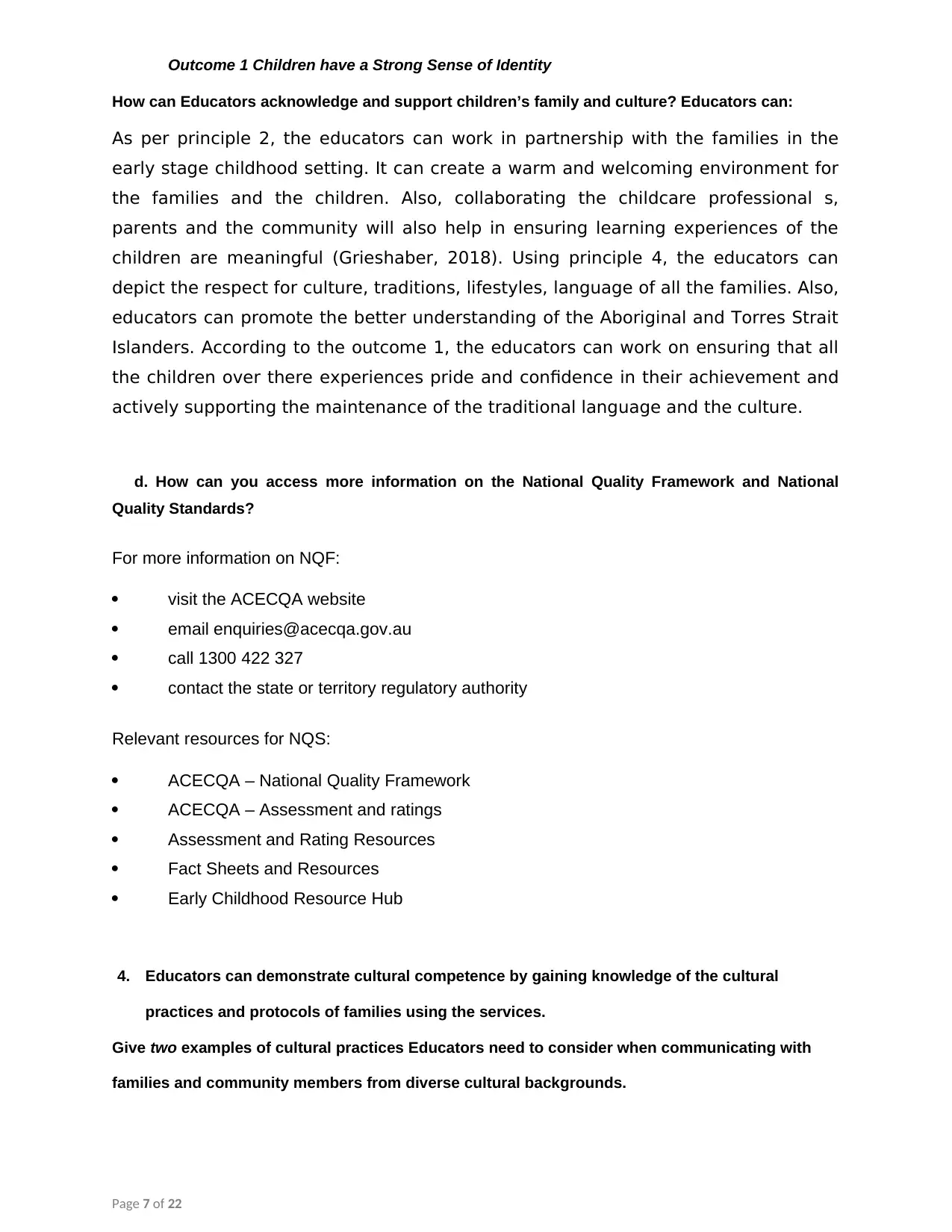
Outcome 1 Children have a Strong Sense of Identity
How can Educators acknowledge and support children’s family and culture? Educators can:
As per principle 2, the educators can work in partnership with the families in the
early stage childhood setting. It can create a warm and welcoming environment for
the families and the children. Also, collaborating the childcare professional s,
parents and the community will also help in ensuring learning experiences of the
children are meaningful (Grieshaber, 2018). Using principle 4, the educators can
depict the respect for culture, traditions, lifestyles, language of all the families. Also,
educators can promote the better understanding of the Aboriginal and Torres Strait
Islanders. According to the outcome 1, the educators can work on ensuring that all
the children over there experiences pride and confidence in their achievement and
actively supporting the maintenance of the traditional language and the culture.
d. How can you access more information on the National Quality Framework and National
Quality Standards?
For more information on NQF:
visit the ACECQA website
email enquiries@acecqa.gov.au
call 1300 422 327
contact the state or territory regulatory authority
Relevant resources for NQS:
ACECQA – National Quality Framework
ACECQA – Assessment and ratings
Assessment and Rating Resources
Fact Sheets and Resources
Early Childhood Resource Hub
4. Educators can demonstrate cultural competence by gaining knowledge of the cultural
practices and protocols of families using the services.
Give two examples of cultural practices Educators need to consider when communicating with
families and community members from diverse cultural backgrounds.
Page 7 of 22
How can Educators acknowledge and support children’s family and culture? Educators can:
As per principle 2, the educators can work in partnership with the families in the
early stage childhood setting. It can create a warm and welcoming environment for
the families and the children. Also, collaborating the childcare professional s,
parents and the community will also help in ensuring learning experiences of the
children are meaningful (Grieshaber, 2018). Using principle 4, the educators can
depict the respect for culture, traditions, lifestyles, language of all the families. Also,
educators can promote the better understanding of the Aboriginal and Torres Strait
Islanders. According to the outcome 1, the educators can work on ensuring that all
the children over there experiences pride and confidence in their achievement and
actively supporting the maintenance of the traditional language and the culture.
d. How can you access more information on the National Quality Framework and National
Quality Standards?
For more information on NQF:
visit the ACECQA website
email enquiries@acecqa.gov.au
call 1300 422 327
contact the state or territory regulatory authority
Relevant resources for NQS:
ACECQA – National Quality Framework
ACECQA – Assessment and ratings
Assessment and Rating Resources
Fact Sheets and Resources
Early Childhood Resource Hub
4. Educators can demonstrate cultural competence by gaining knowledge of the cultural
practices and protocols of families using the services.
Give two examples of cultural practices Educators need to consider when communicating with
families and community members from diverse cultural backgrounds.
Page 7 of 22
Paraphrase This Document
Need a fresh take? Get an instant paraphrase of this document with our AI Paraphraser
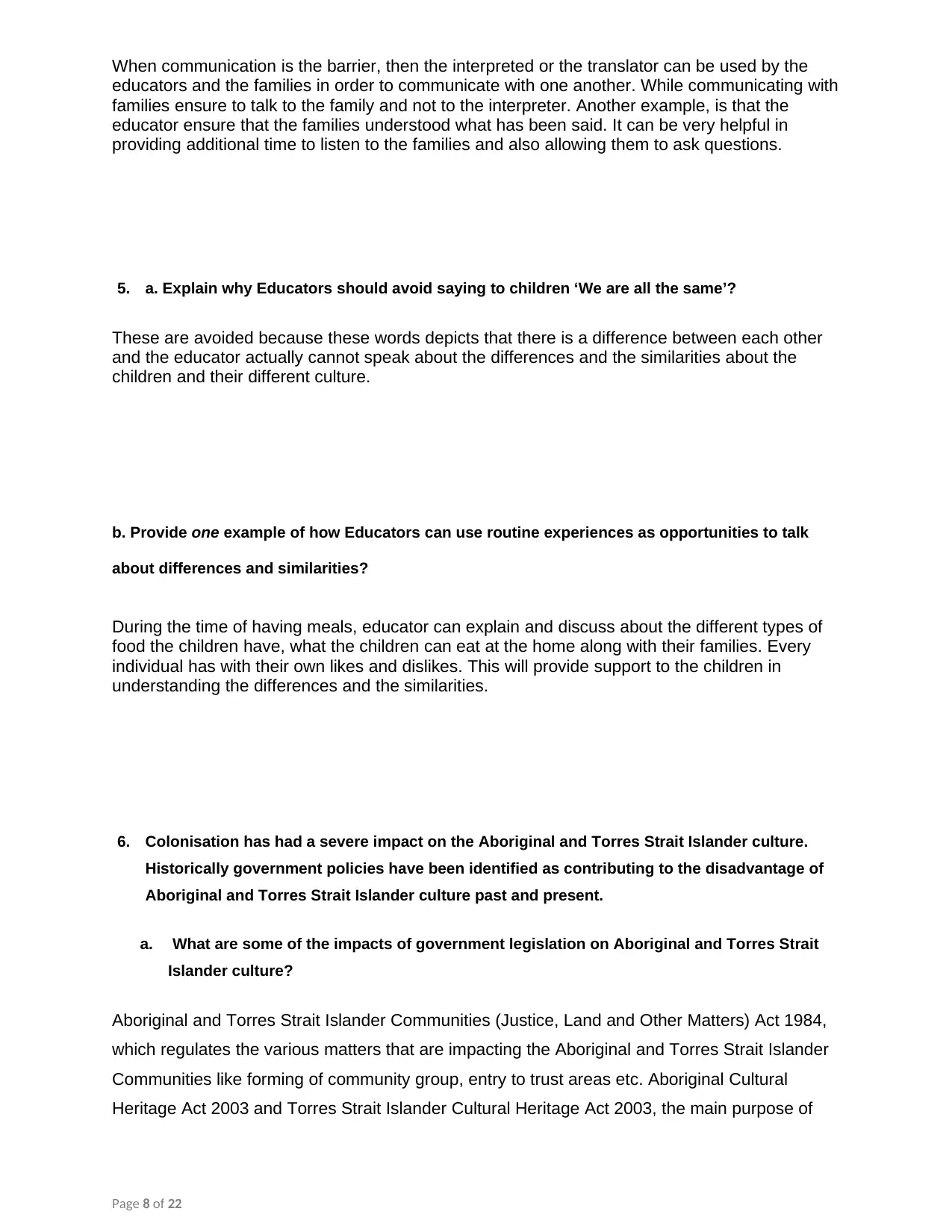
When communication is the barrier, then the interpreted or the translator can be used by the
educators and the families in order to communicate with one another. While communicating with
families ensure to talk to the family and not to the interpreter. Another example, is that the
educator ensure that the families understood what has been said. It can be very helpful in
providing additional time to listen to the families and also allowing them to ask questions.
5. a. Explain why Educators should avoid saying to children ‘We are all the same’?
These are avoided because these words depicts that there is a difference between each other
and the educator actually cannot speak about the differences and the similarities about the
children and their different culture.
b. Provide one example of how Educators can use routine experiences as opportunities to talk
about differences and similarities?
During the time of having meals, educator can explain and discuss about the different types of
food the children have, what the children can eat at the home along with their families. Every
individual has with their own likes and dislikes. This will provide support to the children in
understanding the differences and the similarities.
6. Colonisation has had a severe impact on the Aboriginal and Torres Strait Islander culture.
Historically government policies have been identified as contributing to the disadvantage of
Aboriginal and Torres Strait Islander culture past and present.
a. What are some of the impacts of government legislation on Aboriginal and Torres Strait
Islander culture?
Aboriginal and Torres Strait Islander Communities (Justice, Land and Other Matters) Act 1984,
which regulates the various matters that are impacting the Aboriginal and Torres Strait Islander
Communities like forming of community group, entry to trust areas etc. Aboriginal Cultural
Heritage Act 2003 and Torres Strait Islander Cultural Heritage Act 2003, the main purpose of
Page 8 of 22
educators and the families in order to communicate with one another. While communicating with
families ensure to talk to the family and not to the interpreter. Another example, is that the
educator ensure that the families understood what has been said. It can be very helpful in
providing additional time to listen to the families and also allowing them to ask questions.
5. a. Explain why Educators should avoid saying to children ‘We are all the same’?
These are avoided because these words depicts that there is a difference between each other
and the educator actually cannot speak about the differences and the similarities about the
children and their different culture.
b. Provide one example of how Educators can use routine experiences as opportunities to talk
about differences and similarities?
During the time of having meals, educator can explain and discuss about the different types of
food the children have, what the children can eat at the home along with their families. Every
individual has with their own likes and dislikes. This will provide support to the children in
understanding the differences and the similarities.
6. Colonisation has had a severe impact on the Aboriginal and Torres Strait Islander culture.
Historically government policies have been identified as contributing to the disadvantage of
Aboriginal and Torres Strait Islander culture past and present.
a. What are some of the impacts of government legislation on Aboriginal and Torres Strait
Islander culture?
Aboriginal and Torres Strait Islander Communities (Justice, Land and Other Matters) Act 1984,
which regulates the various matters that are impacting the Aboriginal and Torres Strait Islander
Communities like forming of community group, entry to trust areas etc. Aboriginal Cultural
Heritage Act 2003 and Torres Strait Islander Cultural Heritage Act 2003, the main purpose of
Page 8 of 22
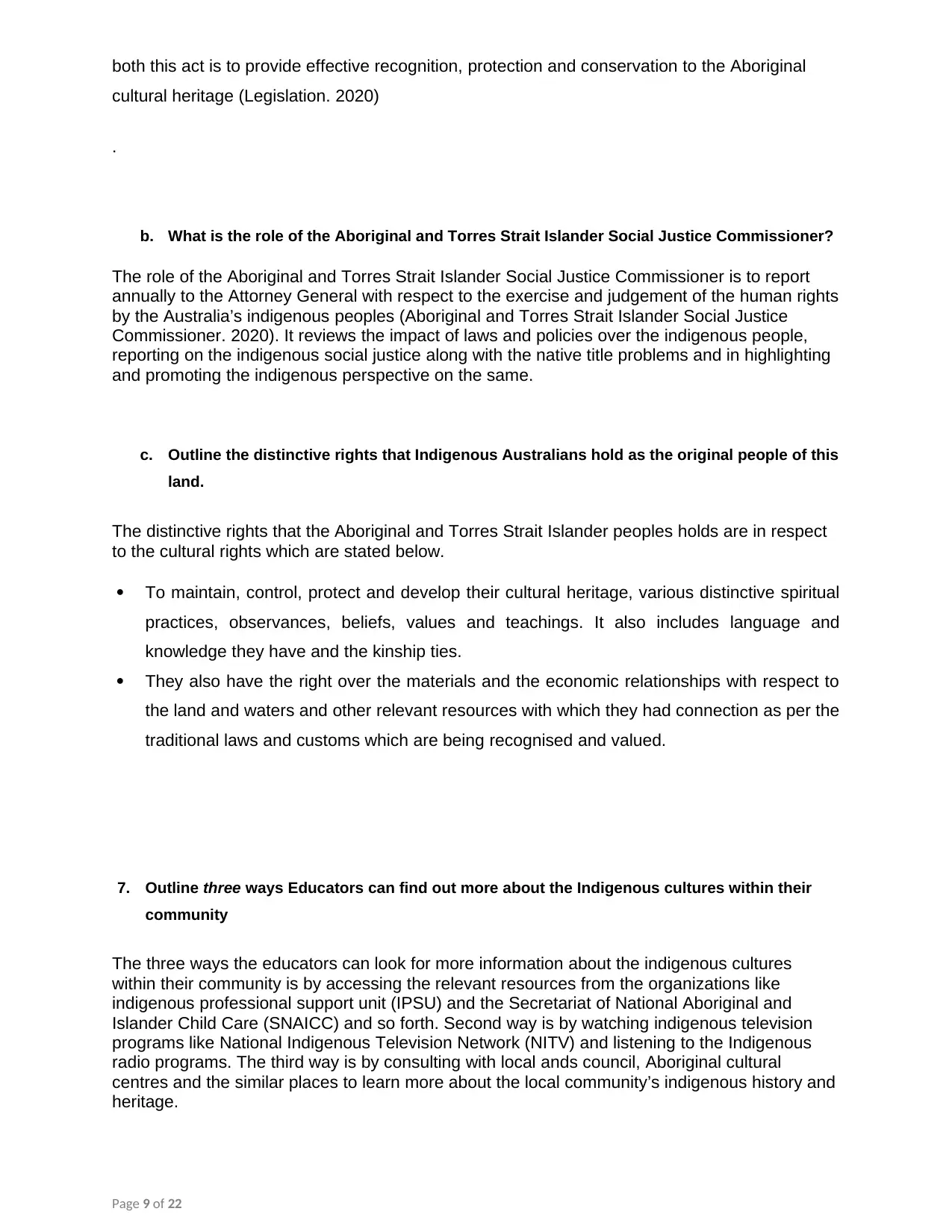
both this act is to provide effective recognition, protection and conservation to the Aboriginal
cultural heritage (Legislation. 2020)
.
b. What is the role of the Aboriginal and Torres Strait Islander Social Justice Commissioner?
The role of the Aboriginal and Torres Strait Islander Social Justice Commissioner is to report
annually to the Attorney General with respect to the exercise and judgement of the human rights
by the Australia’s indigenous peoples (Aboriginal and Torres Strait Islander Social Justice
Commissioner. 2020). It reviews the impact of laws and policies over the indigenous people,
reporting on the indigenous social justice along with the native title problems and in highlighting
and promoting the indigenous perspective on the same.
c. Outline the distinctive rights that Indigenous Australians hold as the original people of this
land.
The distinctive rights that the Aboriginal and Torres Strait Islander peoples holds are in respect
to the cultural rights which are stated below.
To maintain, control, protect and develop their cultural heritage, various distinctive spiritual
practices, observances, beliefs, values and teachings. It also includes language and
knowledge they have and the kinship ties.
They also have the right over the materials and the economic relationships with respect to
the land and waters and other relevant resources with which they had connection as per the
traditional laws and customs which are being recognised and valued.
7. Outline three ways Educators can find out more about the Indigenous cultures within their
community
The three ways the educators can look for more information about the indigenous cultures
within their community is by accessing the relevant resources from the organizations like
indigenous professional support unit (IPSU) and the Secretariat of National Aboriginal and
Islander Child Care (SNAICC) and so forth. Second way is by watching indigenous television
programs like National Indigenous Television Network (NITV) and listening to the Indigenous
radio programs. The third way is by consulting with local ands council, Aboriginal cultural
centres and the similar places to learn more about the local community’s indigenous history and
heritage.
Page 9 of 22
cultural heritage (Legislation. 2020)
.
b. What is the role of the Aboriginal and Torres Strait Islander Social Justice Commissioner?
The role of the Aboriginal and Torres Strait Islander Social Justice Commissioner is to report
annually to the Attorney General with respect to the exercise and judgement of the human rights
by the Australia’s indigenous peoples (Aboriginal and Torres Strait Islander Social Justice
Commissioner. 2020). It reviews the impact of laws and policies over the indigenous people,
reporting on the indigenous social justice along with the native title problems and in highlighting
and promoting the indigenous perspective on the same.
c. Outline the distinctive rights that Indigenous Australians hold as the original people of this
land.
The distinctive rights that the Aboriginal and Torres Strait Islander peoples holds are in respect
to the cultural rights which are stated below.
To maintain, control, protect and develop their cultural heritage, various distinctive spiritual
practices, observances, beliefs, values and teachings. It also includes language and
knowledge they have and the kinship ties.
They also have the right over the materials and the economic relationships with respect to
the land and waters and other relevant resources with which they had connection as per the
traditional laws and customs which are being recognised and valued.
7. Outline three ways Educators can find out more about the Indigenous cultures within their
community
The three ways the educators can look for more information about the indigenous cultures
within their community is by accessing the relevant resources from the organizations like
indigenous professional support unit (IPSU) and the Secretariat of National Aboriginal and
Islander Child Care (SNAICC) and so forth. Second way is by watching indigenous television
programs like National Indigenous Television Network (NITV) and listening to the Indigenous
radio programs. The third way is by consulting with local ands council, Aboriginal cultural
centres and the similar places to learn more about the local community’s indigenous history and
heritage.
Page 9 of 22
⊘ This is a preview!⊘
Do you want full access?
Subscribe today to unlock all pages.

Trusted by 1+ million students worldwide
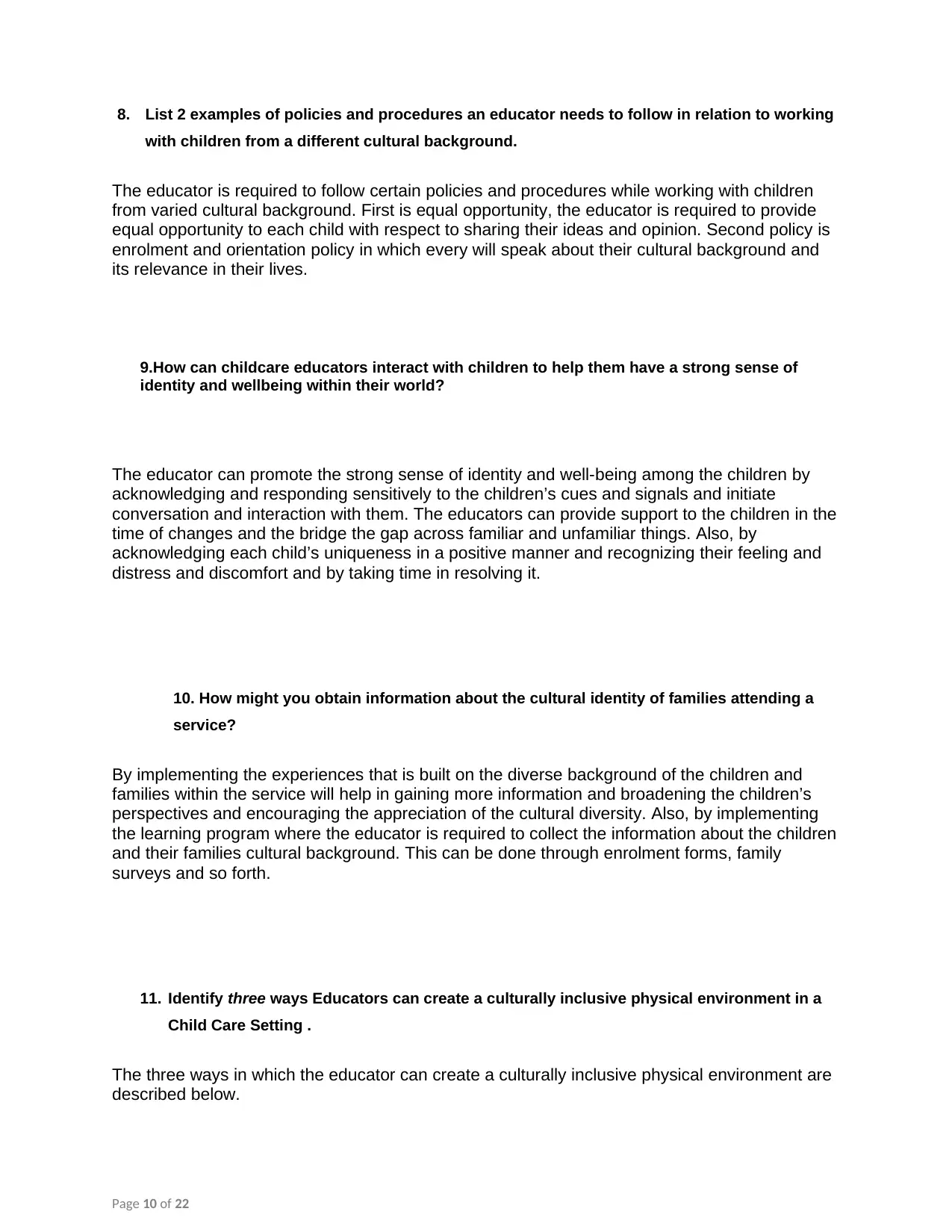
8. List 2 examples of policies and procedures an educator needs to follow in relation to working
with children from a different cultural background.
The educator is required to follow certain policies and procedures while working with children
from varied cultural background. First is equal opportunity, the educator is required to provide
equal opportunity to each child with respect to sharing their ideas and opinion. Second policy is
enrolment and orientation policy in which every will speak about their cultural background and
its relevance in their lives.
9.How can childcare educators interact with children to help them have a strong sense of
identity and wellbeing within their world?
The educator can promote the strong sense of identity and well-being among the children by
acknowledging and responding sensitively to the children’s cues and signals and initiate
conversation and interaction with them. The educators can provide support to the children in the
time of changes and the bridge the gap across familiar and unfamiliar things. Also, by
acknowledging each child’s uniqueness in a positive manner and recognizing their feeling and
distress and discomfort and by taking time in resolving it.
10. How might you obtain information about the cultural identity of families attending a
service?
By implementing the experiences that is built on the diverse background of the children and
families within the service will help in gaining more information and broadening the children’s
perspectives and encouraging the appreciation of the cultural diversity. Also, by implementing
the learning program where the educator is required to collect the information about the children
and their families cultural background. This can be done through enrolment forms, family
surveys and so forth.
11. Identify three ways Educators can create a culturally inclusive physical environment in a
Child Care Setting .
The three ways in which the educator can create a culturally inclusive physical environment are
described below.
Page 10 of 22
with children from a different cultural background.
The educator is required to follow certain policies and procedures while working with children
from varied cultural background. First is equal opportunity, the educator is required to provide
equal opportunity to each child with respect to sharing their ideas and opinion. Second policy is
enrolment and orientation policy in which every will speak about their cultural background and
its relevance in their lives.
9.How can childcare educators interact with children to help them have a strong sense of
identity and wellbeing within their world?
The educator can promote the strong sense of identity and well-being among the children by
acknowledging and responding sensitively to the children’s cues and signals and initiate
conversation and interaction with them. The educators can provide support to the children in the
time of changes and the bridge the gap across familiar and unfamiliar things. Also, by
acknowledging each child’s uniqueness in a positive manner and recognizing their feeling and
distress and discomfort and by taking time in resolving it.
10. How might you obtain information about the cultural identity of families attending a
service?
By implementing the experiences that is built on the diverse background of the children and
families within the service will help in gaining more information and broadening the children’s
perspectives and encouraging the appreciation of the cultural diversity. Also, by implementing
the learning program where the educator is required to collect the information about the children
and their families cultural background. This can be done through enrolment forms, family
surveys and so forth.
11. Identify three ways Educators can create a culturally inclusive physical environment in a
Child Care Setting .
The three ways in which the educator can create a culturally inclusive physical environment are
described below.
Page 10 of 22
Paraphrase This Document
Need a fresh take? Get an instant paraphrase of this document with our AI Paraphraser
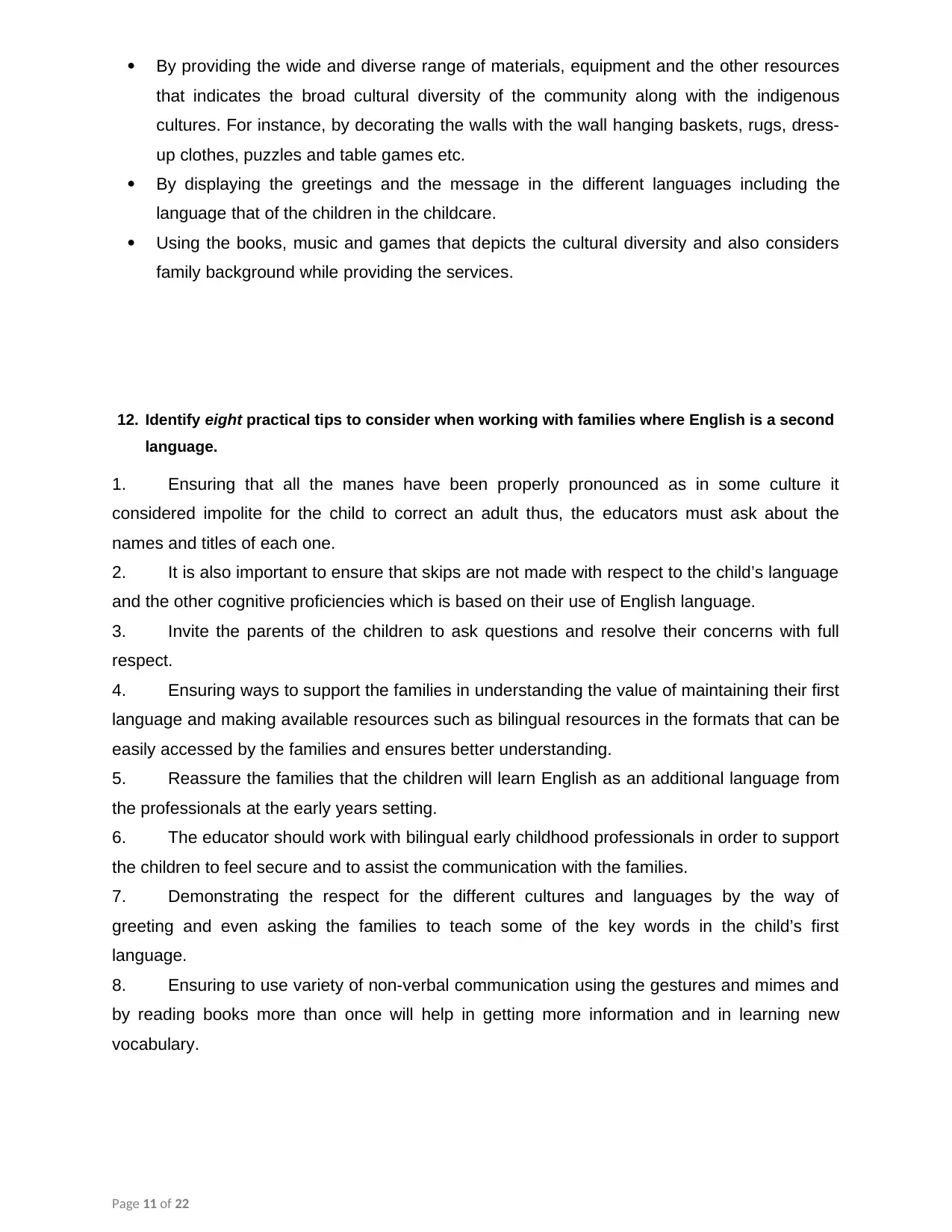
By providing the wide and diverse range of materials, equipment and the other resources
that indicates the broad cultural diversity of the community along with the indigenous
cultures. For instance, by decorating the walls with the wall hanging baskets, rugs, dress-
up clothes, puzzles and table games etc.
By displaying the greetings and the message in the different languages including the
language that of the children in the childcare.
Using the books, music and games that depicts the cultural diversity and also considers
family background while providing the services.
12. Identify eight practical tips to consider when working with families where English is a second
language.
1. Ensuring that all the manes have been properly pronounced as in some culture it
considered impolite for the child to correct an adult thus, the educators must ask about the
names and titles of each one.
2. It is also important to ensure that skips are not made with respect to the child’s language
and the other cognitive proficiencies which is based on their use of English language.
3. Invite the parents of the children to ask questions and resolve their concerns with full
respect.
4. Ensuring ways to support the families in understanding the value of maintaining their first
language and making available resources such as bilingual resources in the formats that can be
easily accessed by the families and ensures better understanding.
5. Reassure the families that the children will learn English as an additional language from
the professionals at the early years setting.
6. The educator should work with bilingual early childhood professionals in order to support
the children to feel secure and to assist the communication with the families.
7. Demonstrating the respect for the different cultures and languages by the way of
greeting and even asking the families to teach some of the key words in the child’s first
language.
8. Ensuring to use variety of non-verbal communication using the gestures and mimes and
by reading books more than once will help in getting more information and in learning new
vocabulary.
Page 11 of 22
that indicates the broad cultural diversity of the community along with the indigenous
cultures. For instance, by decorating the walls with the wall hanging baskets, rugs, dress-
up clothes, puzzles and table games etc.
By displaying the greetings and the message in the different languages including the
language that of the children in the childcare.
Using the books, music and games that depicts the cultural diversity and also considers
family background while providing the services.
12. Identify eight practical tips to consider when working with families where English is a second
language.
1. Ensuring that all the manes have been properly pronounced as in some culture it
considered impolite for the child to correct an adult thus, the educators must ask about the
names and titles of each one.
2. It is also important to ensure that skips are not made with respect to the child’s language
and the other cognitive proficiencies which is based on their use of English language.
3. Invite the parents of the children to ask questions and resolve their concerns with full
respect.
4. Ensuring ways to support the families in understanding the value of maintaining their first
language and making available resources such as bilingual resources in the formats that can be
easily accessed by the families and ensures better understanding.
5. Reassure the families that the children will learn English as an additional language from
the professionals at the early years setting.
6. The educator should work with bilingual early childhood professionals in order to support
the children to feel secure and to assist the communication with the families.
7. Demonstrating the respect for the different cultures and languages by the way of
greeting and even asking the families to teach some of the key words in the child’s first
language.
8. Ensuring to use variety of non-verbal communication using the gestures and mimes and
by reading books more than once will help in getting more information and in learning new
vocabulary.
Page 11 of 22
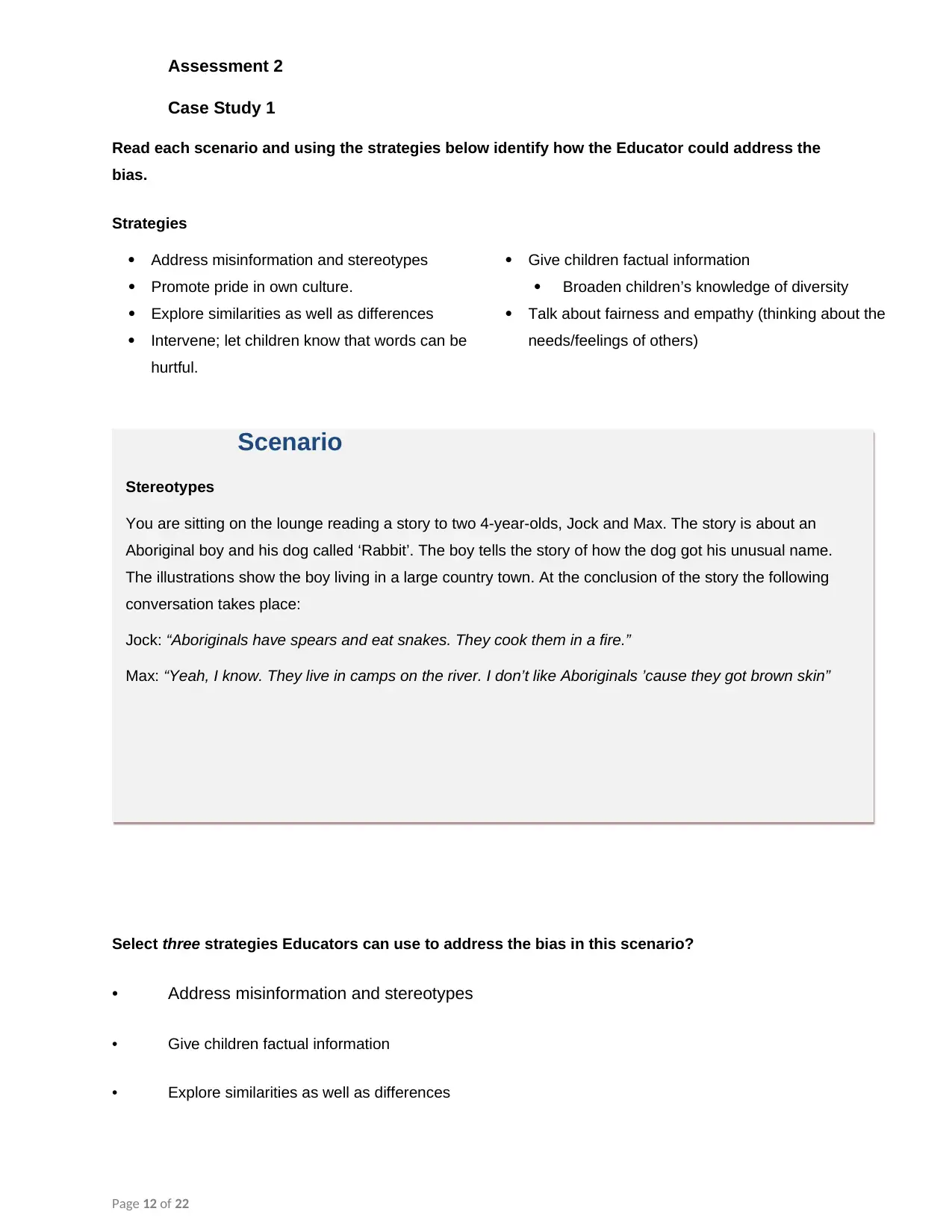
Assessment 2
Case Study 1
Read each scenario and using the strategies below identify how the Educator could address the
bias.
Strategies
Address misinformation and stereotypes
Promote pride in own culture.
Explore similarities as well as differences
Intervene; let children know that words can be
hurtful.
Give children factual information
Broaden children’s knowledge of diversity
Talk about fairness and empathy (thinking about the
needs/feelings of others)
Select three strategies Educators can use to address the bias in this scenario?
• Address misinformation and stereotypes
• Give children factual information
• Explore similarities as well as differences
Page 12 of 22
Scenario
Stereotypes
You are sitting on the lounge reading a story to two 4-year-olds, Jock and Max. The story is about an
Aboriginal boy and his dog called ‘Rabbit’. The boy tells the story of how the dog got his unusual name.
The illustrations show the boy living in a large country town. At the conclusion of the story the following
conversation takes place:
Jock: “Aboriginals have spears and eat snakes. They cook them in a fire.”
Max: “Yeah, I know. They live in camps on the river. I don’t like Aboriginals ’cause they got brown skin”
Case Study 1
Read each scenario and using the strategies below identify how the Educator could address the
bias.
Strategies
Address misinformation and stereotypes
Promote pride in own culture.
Explore similarities as well as differences
Intervene; let children know that words can be
hurtful.
Give children factual information
Broaden children’s knowledge of diversity
Talk about fairness and empathy (thinking about the
needs/feelings of others)
Select three strategies Educators can use to address the bias in this scenario?
• Address misinformation and stereotypes
• Give children factual information
• Explore similarities as well as differences
Page 12 of 22
Scenario
Stereotypes
You are sitting on the lounge reading a story to two 4-year-olds, Jock and Max. The story is about an
Aboriginal boy and his dog called ‘Rabbit’. The boy tells the story of how the dog got his unusual name.
The illustrations show the boy living in a large country town. At the conclusion of the story the following
conversation takes place:
Jock: “Aboriginals have spears and eat snakes. They cook them in a fire.”
Max: “Yeah, I know. They live in camps on the river. I don’t like Aboriginals ’cause they got brown skin”
⊘ This is a preview!⊘
Do you want full access?
Subscribe today to unlock all pages.

Trusted by 1+ million students worldwide
1 out of 22
Related Documents
Your All-in-One AI-Powered Toolkit for Academic Success.
+13062052269
info@desklib.com
Available 24*7 on WhatsApp / Email
![[object Object]](/_next/static/media/star-bottom.7253800d.svg)
Unlock your academic potential
Copyright © 2020–2025 A2Z Services. All Rights Reserved. Developed and managed by ZUCOL.





